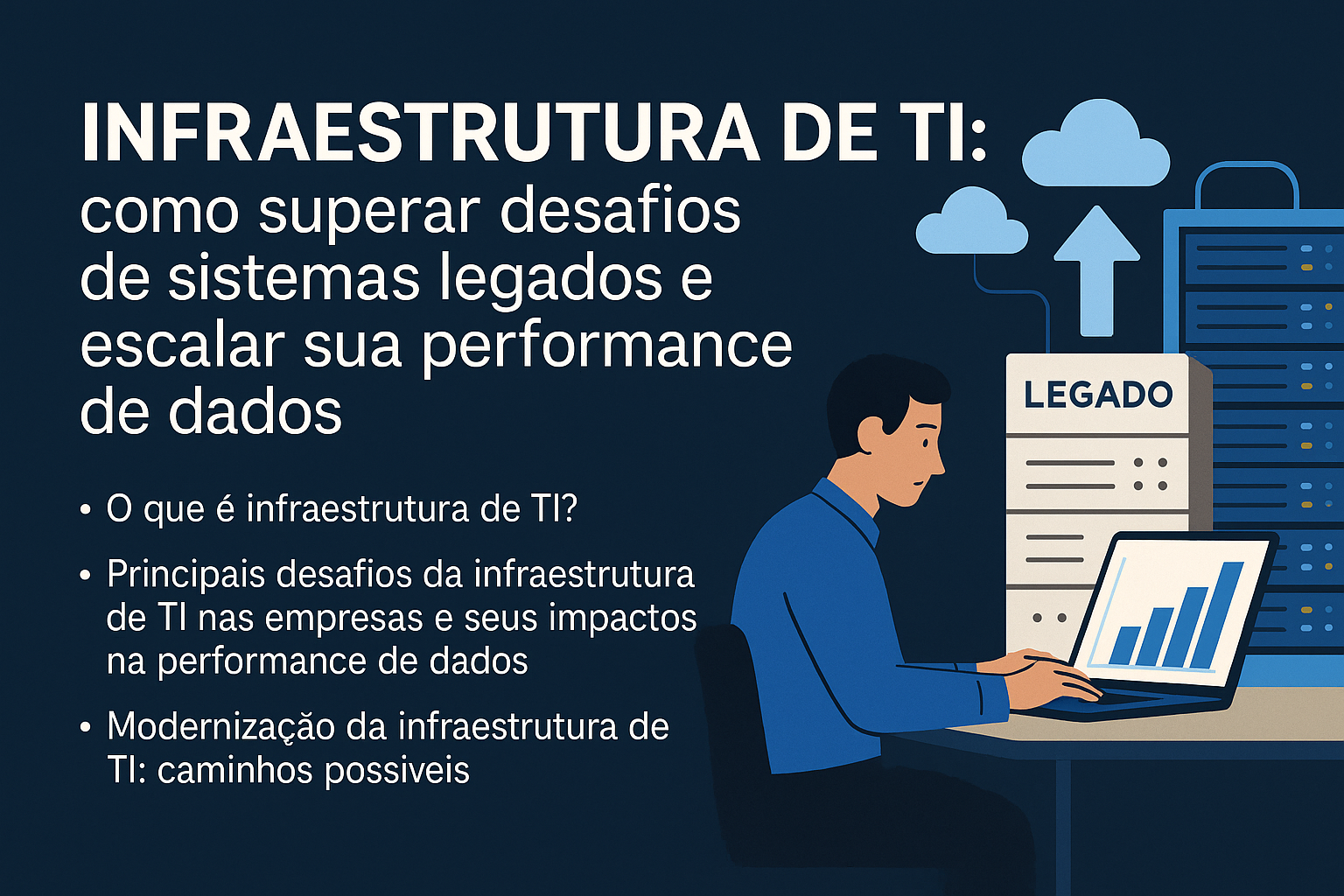IT infrastructure is no longer just a set of servers, cables, and support systems — it has become one of the most strategic pillars of business. Today, it ensures not only the daily operations of companies but also the agility and ability to innovate in an increasingly competitive market.
However, many organizations still face the burden of legacy systems. A legacy system is a technological solution developed decades ago that companies continue to use, but it has become a problem as it can no longer keep up with current demands.
This results in low performance, difficulty integrating with modern tools, high maintenance costs, lack of scalability, security vulnerabilities, and operational inefficiency — all of which delay decision-making and block the adoption of new technologies.
Given this scenario, modernizing IT infrastructure is no longer an option: it is a strategic necessity. Adopting solutions that make IT more flexible, secure, and data-driven can be the key differentiator between stagnation and scaling results. In this article, we will explore the main challenges, modernization paths, and best practices to transform IT infrastructure into a growth engine for your business.
What is IT Infrastructure?
IT infrastructure is the set of technological components — both physical and virtual — that support an organization’s processes and operations. It includes servers, networks, storage devices, operating systems, databases, enterprise software, information security, and increasingly, cloud resources.
In practical terms, IT infrastructure is responsible for:
- Ensuring connectivity between systems, teams, and customers;
- Supporting critical applications that keep the business running;
- Storing and processing data to enable strategic analysis;
- Ensuring security and compliance, protecting sensitive information.
Traditional Infrastructure vs. Modern Infrastructure
- Traditional: based on on-premises servers, with high maintenance costs, scalability limitations, and slow update processes.
- Modern: cloud-oriented, with elastic resources, automation, high availability, and integration with emerging technologies such as Artificial Intelligence and Big Data.
More than just operational support, IT infrastructure has become a strategic differentiator: companies with agile structures can respond quickly to market changes, adopt innovations faster, and leverage data to gain a competitive advantage.
Main challenges of IT Infrastructure in companies and their impact on data performance
Maintaining an efficient IT infrastructure is a constant challenge for companies that need to balance costs, security, and innovation capacity. Without a clear modernization strategy, organizations face obstacles that reduce data performance and compromise competitiveness.
1. Legacy Systems: performance, integration, and cost limitations
Many businesses still rely on systems developed decades ago that no longer keep up with current demands. These solutions present:
- Low performance: slow processing of large data volumes;
- Integration difficulties: incompatibility with modern tools;
- High maintenance costs: continuous investments in support and fixes.
The result is a rigid environment that delays decision-making and prevents the adoption of new technologies.
2. Scalability: how to grow without compromising stability
One of the biggest pain points of traditional infrastructure is the lack of elasticity. As the number of users or the amount of processed data increases, the system may lose stability and even face critical failures. This creates:
- Bottlenecks in customer service;
- Risks of downtime;
- Direct impacts on the end-user experience.
Companies that cannot scale quickly miss growth opportunities and fall behind in dynamic markets.
3. Security and Compliance: risks of maintaining obsolete infrastructure
Old solutions without frequent updates become vulnerable to cyberattacks and compliance failures with regulations such as the LGPD. Among the risks are:
- Exposure of sensitive data;
- Fines and penalties for not meeting legal requirements;
- Damage to brand reputation with clients and partners.
Modernizing infrastructure is, therefore, also a matter of protection and credibility.
4. Hidden Costs: maintenance, rework, and loss of efficiency
Although many companies avoid investing in modernization to “save money,” the reality shows the opposite:
- High spending on corrective maintenance;
- IT teams stuck in rework, spending time putting out fires instead of innovating;
- Operational inefficiency, with underutilized or poorly allocated resources.
These hidden costs erode the budget and reduce competitiveness margins.
5. Data Management: slowness and low reliability
When infrastructure is not designed to handle large volumes, issues such as the following emerge:
- Slow processing of reports and analyses;
- Inconsistent or duplicated data;
- Lack of reliability in strategic information.
This generates insecurity in decision-making, as managers cannot fully trust the data presented.
Direct impacts on performance and competitiveness
All these challenges significantly affect data performance. Companies that maintain outdated infrastructures face difficulties adopting technologies such as Artificial Intelligence, Analytics, and Business Intelligence.
In addition, legacy infrastructure leads to a loss of agility compared to competitors already using modern environments, and creates a greater competitive risk by failing to transform data into valuable insights.
In short, without modernization, IT infrastructure with poorly documented and disorganized legacy systems ceases to be a strategic asset and becomes a barrier to growth.
IT Infrastructure modernization: possible paths
Overcoming the challenges imposed by legacy systems and achieving higher performance requires a structured IT infrastructure modernization strategy. The goal is to build an environment that is more agile, flexible, and prepared to sustain business growth. Among the main paths are:
1. Cloud Migration (cloud-first and cloud-hybrid)
Adopting a cloud-first strategy means prioritizing applications and data in cloud environments whenever possible, reducing dependency on on-premises servers. The cloud-hybrid model, on the other hand, combines public cloud, private cloud, and on-premises infrastructure, offering greater flexibility.
Benefits:
- Reduced costs with physical server maintenance;
- Elastic scalability: ability to increase or decrease resources as needed;
- Easier integration with modern data and analytics tools.
2. Adoption of modern stacks and frameworks
Updating the ecosystem of tools and languages to modern stacks and frameworks is an essential step to ensure performance, security, and scalability. In the context of ETL, Data Engineering, and BI, this means replacing manual pipelines or rigid solutions with more flexible architectures, such as Delta Lakehouse with Databricks and Spark, orchestration with Apache Airflow, and integrations through Azure Data Factory or AWS Glue. On the analytics front-end, it may include using Power BI with optimized models or even dbt for data modeling and version control.
3. Process automation and orchestration
Automating repetitive tasks and orchestrating workflows across the infrastructure reduces human error and increases efficiency.
Benefits:
- Agility in deploying new services;
- Faster response time to incidents;
- More team time dedicated to innovation instead of maintenance.
4. Integration with Business Intelligence and Data Analytics Solutions
Modern infrastructure must be prepared to handle large volumes of data and integrate them with BI e Analytics tools. This ensures that data from different sources is processed quickly and with quality, enabling deeper analysis.
Benefits:
- Fast and reliable insights for decision-making;
- Support for adata-driven culture;;
- Ability to leverage advanced technologies such as Artificial Intelligence and Machine Learning.
These paths are not mutually exclusive — on the contrary, they complement each other. A company can adopt hybrid cloud, automate processes, and at the same time integrate its infrastructure with analytics solutions. The result is a more resilient, scalable environment, ready to transform data into strategic value.
Best Practices for IT Infrastructure Management
For IT infrastructure modernization to truly sustain business growth and provide a competitive edge, it is necessary to adopt management practices that ensure efficiency, security, and strategic alignment. Among the most important are:
1. Strategic planning and alignment with business objectives
IT infrastructure should be seen as a strategic asset. This means that technology investments must be aligned with the organization’s goals — whether it is market expansion, improving customer experience, or reducing operational costs.
- Avoids wasting resources on solutions with no real impact;
- Ensures IT is at the service of corporate strategy;
- Facilitates top leadership engagement in the digital transformation journey.
2. Data governance and compliance
With the exponential growth of data and regulations such as LGPD governance is no longer optional. Defining clear rules about who can access, use, and manage data is essential to reduce risks.
- Protection against sensitive data leaks;
- Compliance with national and international regulations;
- Greater reliability of data used in analyses and reports.
3. Adoption of agile methodologies and DevOps
The integration between development and operations, promoted by DevOps, brings greater speed and efficiency to IT projects. At the same time, agile methodologies ensure flexibility in demand management.
- Faster and incremental deliveries;
- Greater collaboration between technical and business teams;
- Ability to adapt to market changes.
4. Continuous monitoring and proactive risk management
Modern infrastructure must be monitored in real time, with tools that identify failures before they impact the business. In addition, proactive risk management ensures quick responses to incidents.
- Reduced downtime;
- Early detection of security vulnerabilities;
- Continuity of essential services for company operations.
5. Data-driven culture to sustain growth
More than just technology, true transformation depends on organizational culture. A data-driven culture ensures that decisions are based on reliable data, rather than intuition.
- Encourages the use of BI and Analytics tools;
- Improves the accuracy of strategic decisions;
- Sustains innovation and growth in a scalable way.
Conclusion
IT infrastructure is more than just technical support: it has become one of the main factors that determine agility, security, and competitiveness in today’s market. However, when based on legacy systems and outdated processes, it turns into a major obstacle to innovation and scalability.
Modernization paths — such as cloud migration, process automation, and integration with BI and Analytics solutions — show that it is possible to build a more agile environment prepared for the future. And by adopting best management practices, such as strategic planning, data governance, and a data-driven culture, organizations can extract maximum value from technology.
In a scenario where data performance is a competitive differentiator, investing in modern, well-managed IT infrastructure is not just a technological decision, but a sustainable growth strategy. Companies that recognize this early will have greater chances to innovate, respond quickly to market changes, and achieve lasting competitive advantage.
The process of IT infrastructure modernization requires careful planning, technical expertise, and strategic vision. At this point, relying on specialized consulting makes all the difference. Experienced professionals help to:
- Map bottlenecks and improvement opportunities;
- Define the best strategy between cloud, automation, and data integration;
- Implement solutions with lower risk and faster speed;
- Prepare the company to sustain a truly data-driven culture.
With the right support, the journey is no longer a solitary challenge but a guided transformation, ensuring that technology truly serves business objectives.
If your company is ready to evolve, modernize IT infrastructure, and scale data performance, the next step is to seek guidance from specialists.
At equal, we help companies modernize their IT infrastructure and scale data performance with security and efficiency. 📩 Contact us today and discover how to turn your IT into a true growth engine for your business.



